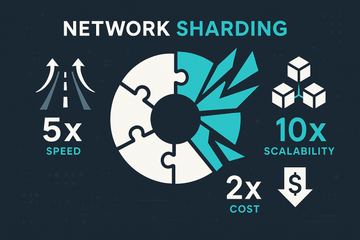If you spend any time chatting about blockchain, databases, or even online gaming, the word “shard” pops up often. But what are shards, really? Let’s break down this small but mighty piece of digital architecture, and see how cross-cutting it is—from crypto wallets to sprawling online worlds, from Trezor to Ledger, and honestly, maybe even your favorite multiplayer game.
Shards: More Than Just Scraps
So, here’s the thing. When people say “shard” in the world of technology, they usually mean a sliver of a much larger piece of data or network. Imagine splitting a pizza so a dozen friends can each grab a slice. Eating alone? That’s one thing. Feeding a group? You want pizza shards so everyone can enjoy a piece at the same time.
In databases and blockchain, shards refer to these slices: distinct partitions that hold just a portion of your data or network’s activity. Why bother? Let’s jump right in.
Why We Shard: From Traffic Jams to Superhighways
Picture an old downtown road, jammed every rush hour. Now, imagine building three parallel roads. Suddenly, traffic thins, everyone moves faster, and nobody’s stuck honking the horn. Sharding follows the same logic. By splitting the data or workload, you avoid bottlenecks.
Here’s where blockchains like Ethereum get interesting. Sharding in this context lets the network process many transactions across several lanes—or shards—at once. Instead of every transaction screaming to be heard in one crowded hallway, each gets its own corridor. The result? Better speed and scalability.
- Lower congestion: Transactions don’t wait in line as long.
- Faster processing: Networks can handle a greater load.
- Reduced costs: Efficiency climbs, so transaction fees can dip.
You know what? It’s like having extra checkout lanes at the supermarket. Nobody likes standing in a queue with melting ice cream.
How Sharding Helps Blockchains (And You!)
Sharding breaks up a blockchain’s data set so that each node only stores a part of the overall ledger, not the entire thing. Each shard processes its transactions and smart contracts independently, but they all coordinate for consensus. This design makes it possible for thousands, even millions, to use a blockchain like Ethereum without grinding progress to a halt. That’s good news whether you’re playing a blockchain-based game, swapping tokens, or simply securing digital assets in your Ledger or Trezor hardware wallet.
Security Isn’t On the Chopping Block
Okay, you might wonder: “If we split things up, do we become more vulnerable?” It’s a fair question. Security challenges definitely exist. But clever cryptography and consensus protocols stitch the shards together. Like locking each room in your house and then locking the front door, security works at both the shard and network level.
Still, some risks remain. Coordinating these fragments so no attacker can target just one shard and wreak havoc takes careful planning. The good news? Teams like Ethereum’s researchers and those behind innovative wallets (think Trezor and Ledger) are up to the challenge, constantly updating and refining methods.
Wait, Do Regular Databases Use Shards Too?
Not just a blockchain thing! Traditional databases (the everyday engines that power online stores, banks, and even your favorite food delivery app) use sharding to scale up. As demand balloons, sharding lets them handle bigger crowds without redlining the servers.
Consider it like splitting a massive library into separate rooms by genre. Researchers interested in history don’t have to trip over romance readers. Everyone finds what they need, fast. And if the library grows? Just add more rooms—er, shards.
Sneaky Extra: Shards In Unexpected Places
Surprise—shards aren’t just for cryptocurrency or databases. Online multiplayer games use server shards to keep gameplay smooth when thousands log in. Imagine millions storming a single game server. Chaos, lag, and disconnects galore! By sharding, each instance feels just right—populated, but never overcrowded.
And, you know, there’s a bit of poetry here. In literature, a “shard” can mean a remnant of something bigger. Even skyscrapers borrow the name—London’s The Shard darts into the sky, a shard of glass among clouds. Funny how tech borrows from everyday life, right?
If You’re Thinking About Crypto Hardware Wallets
Let’s loop back to something close to every crypto fan’s heart: safety. No matter the backend trickery—sharding in the database that holds your wallet’s records, redundancy in the hardware—your Trezor or Ledger device is designed so you don’t have to sweat about the details. Behind the scenes, these companies constantly watch for scaling bottlenecks and loopholes. So, when sharding pops up in announcements or updates, know it’s part of their effort to keep your digital treasures quick to access and safe from prying eyes.
Challenges, Quirks, and Where We’re Headed Next
Of course, sharding isn’t a magic fix. If shards aren't coordinated, data can get inconsistent, kind of like if half your pizza order was pineapple and the other half... anchovies. Some purists worry that splitting data may create vulnerabilities—or headaches if you want cross-shard transactions.
Yet, as blockchain adoption climbs, sharding grows from trendy buzzword to well-worn tool. Innovations on the horizon—like Ethereum’s next upgrades, or adaptations in crypto wallet backends—will continue making shards smarter, safer, and more seamless.
Bottom Line: Piecing It Together
Here’s my take: Whether you’re juggling crypto assets, building a game, or running a global business, understanding what a shard is lets you see just how modern tech scales up. Shards are like those puzzle pieces that, alone, look insignificant but together create something you’d be lost without—a network that can handle size, speed, and security without breaking a sweat.
So, next time you hear someone grumbling about network congestion or database lag, ask if they’ve considered a slice of the solution. Sometimes, sharing means sharding—one little piece at a time.











